Hesperian Health Guides
A “Playground for All” Built by Children—Projimo, Mexico
HealthWiki > Disabled Village Children > Chapter 46: Playgrounds for All Children > A “Playground for All” Built by Children—Projimo, Mexico
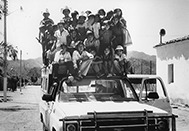 |
| 1. First the children went into the forest to cut poles and vines. |
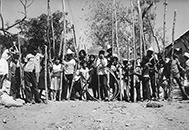 |
| 2. These they brought back to an empty lot at the edge of the village. |
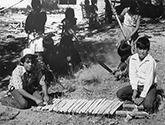 |
| 3. While some children cleaned up the lot, others began to build the playground equipment. |
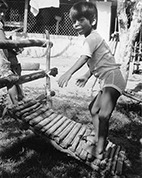 |
| 4. They built ramps or “wedges” like this one, which can be used in many ways for play and exercise. Here a child with cerebral palsy walks up the ramp to help improve balance and stretch his feet upwards to prevent contractures. |
 |
The wedges can also be used by children with severe disabilities to lie on, so that they can lift their heads and play with their hands. |
 |
Pole seats like this help a child sit who still lacks balance, or has trouble controlling his position. | 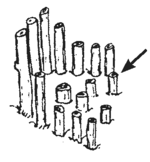 |
These separators will hold apart the legs of a child whose legs pull together due to spasticity. | ||||||

 |
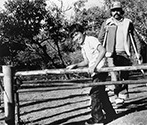 |
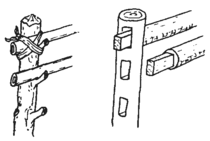 |
| Simple parallel bars can be used as gymnastic bars by children without disabilities... | and as bars for learning to walk by children with disabilities. | Bars need to adjust to different heights for different children. Here are 2 simple ways. |
 |
 |
 |
| For most children, the bar should be about hip height, so that the elbows are a little bent (the same height as the handles of crutches). | A child with very weak upper arms may find it easier to rest his forearms on the bar. The bar will need to be elbow high. | A child who tends to slump forward may be helped to stand straighter if the bar is high, so that he has to stand straighter to rest his arms on it. |
Contents
- 1 SEPARATION OF BARS
- 2 TEETER BRIDGE
- 3 PRECAUTIONS
- 4 CLIMBING FRAME AND HIGH BAR
- 5 TIRE GYM
- 6 SWINGS
- 7 SWINGS AND PLAYTHINGS USING OLD TIRES AND TUBES
- 8 WHIRLYGIG CIRCULAR SWING
- 9 BOUNCING TUBE
- 10 BOUNCING TIRE HOBBY HORSE (OR COW)
- 11 MAYPOLE
- 12 HANGING SEESAW SWING
- 13 OBSTACLE COURSE
- 14 BALANCE BOARDS
- 15 ROLLS
- 16 CRAWL-THROUGH DRUMS
- 17 HANGING CRAWL-THROUGH DRUMS
- 18 RING-TOSS
SEPARATION OF BARS
| Bars should be close enough to leave only a little room on either side of the child’s body. Too close, they get in the way. Too far apart makes weight bearing more difficult. |  |
Smaller children require closer bars. Therefore, put uprights so they are wider higher up. |  |
Simple, homemade bars, adjusted to the individual child’s needs, often provide more benefit than expensive walkers or other equipment.
TEETER BRIDGE

A simple seesaw or teeter-totter like this is fun and helps children with disabilities gain balance. The one in the photo was made by putting a pole in the crotch of a mango tree.
 |
Rocker supports for a seesaw can be made in many ways. |  Some sort of blocking is needed to keep pole from sliding or rolling. | |
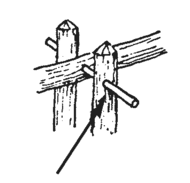 |
 | ||
| One way to prevent rolling and rotating is to pass a metal pipe through the pole. | One end of this seesaw has an enclosed seat for a child with disabilities. Space is left behind the seat for a child without disabilities to sit and assist. | ||

rubber crutch tips to keep from bumping head
strap to hold in child |
 |
||
| On the other end a wooden donkey head adds fun. | |||
Here are some other ideas for seesaws.
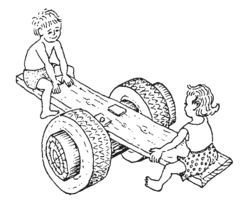 |
 piece of tire turned inside out
band cut from inner tube to hold child in seat
half a plastic bucket
old 55 gallon drum |
PRECAUTIONS
- To avoid accidents, be sure the pole for the seesaw is strong enough. Test it every few weeks by having 2 adults put their full weight on the ends of the pole.
- To avoid coming down too hard, put old tires under the ends of the seesaw.
- Make sure the seesaw will not roll lengthwise or sideways (see above).
See another seesaw idea.
CLIMBING FRAME AND HIGH BAR

Children can make a simple climbing frame out of poles, by nailing them or tying them together with string.
The climbing frame can be used for all kinds of play, for helping children with disabilities pull up to sitting or standing, and for therapy exercise.
High bars (horizontal bars) at different levels for different children can be used for exercise and gymnastics.
TIRE GYM
Climbing gyms can be made out of many materials, including old tires.
| Gym will be more solid if tires are bolted together. |  |
 |
 washer or metal plate
bolt |
||
| The children in the village of Ajoya, Mexico helped those in a nearby town build their own rehabilitation playground. This tire climbing gym was one of the playthings they created. |
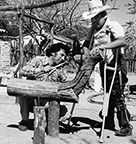 |
 |
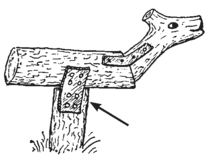 |
| Building and riding a rocking horse made of logs. | Pieces of car tire to join logs allow horse to rock back and forth. | |
SWINGS
A wide variety of swings can be built out of different local materials. Swinging is fun; it can help develop balance, head control, coordination, and strength. Swings with specific features can be built for the needs of particular children.
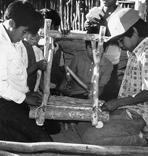 |
 |
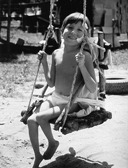 |
| Here children in PROJIMO make an enclosed swing. | This child with cerebral palsy had never had a chance to swing before. At first he was afraid... | but after a while, he loved it. |
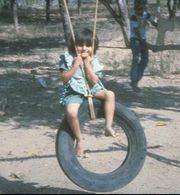 |
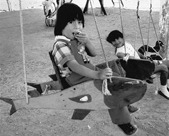 |
 |
| Regular swings are placed next to special and enclosed swings, so that children with and without disabilities learn to play side by side. | Swings in the form of animals or fish add to the fun. | Extra wide swings allow 2 children to swing together—one assisting the other. |

SWINGS AND PLAYTHINGS USING OLD TIRES AND TUBES
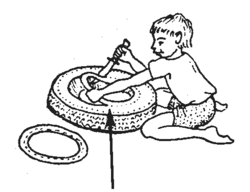
Rings for swinging and many games can be made by cutting out the inner rims of old car tires. |
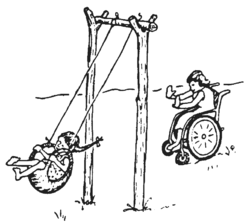 | |
 |
 |
|
| Cut away this part of the tire | Then turn the tire inside out. |
 |
 | |
| This swing made of an old tire is especially good for children with spasticity because it bends their backs, heads, and shoulders forward. | ||
| In this swing, a “floor” of sticks can be put in the tire and covered with straw or a mat. |
| This flat-hanging tire swing is especially useful for a child with severe disabilities who is just beginning to learn to move his body. The child can lie across the tire and move this way and that by pushing the ground with his hands. | It swings! It spins! It bounces! Fun for all children! Several children can play on it at once! |
 |  | |
| Hang tire just a few centimeters from ground so the child can move with his hands. | ||
WHIRLYGIG CIRCULAR SWING
| Cross beam pivots on an iron pipe. | 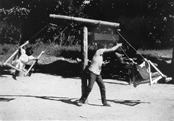 |
 Hole in beam is coated with candle wax to make it turn around easier. | |
| Circular swing in PROJIMO rehabilitation playground. (Here the child pushing the swing has cerebral palsy. The twisting motion he uses is excellent therapy.) |
BOUNCING TUBE
(from Low Cost Physiotherapy and Low Cost Walking Aids.)
 |
Piece of strong canvas or animal hide stretched tight over large truck or airplane inner tube. | 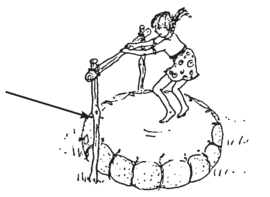 |
BOUNCING TIRE HOBBY HORSE (OR COW)

loops of car inner tube |
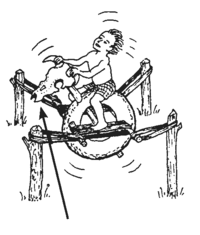 |
 |
| Be sure to notch poles and attach tubes so they do not slip. | A cow’s skull makes a good head for many playground toys. The child holds onto the horns. (Cut off the points.) |
Note: It is much easier to put holes through tires that do not have steel wire in them.
MAYPOLE
Children with disabilities who can sit and hang on can play with other children on the maypole. But to start turning round the circle, they may need another child to help push them.
 top turn-mount made of old car wheel and axle end (see box)
inside rim cut from car tire
car tire inner tube |
| HERE ARE 2 WAYS TO MAKE A TOP TURN-MOUNT |

nut
washer
drum
lug bolts
u-bolts
axle
hole in post |
 Weld steel plate to steel pipe.
Grease fitting
Taper pole to fit pipe.
holes for chains or ropes
Fasten chains with "S" hooks.
STEEL PLATE TOP VIEW |
HANGING SEESAW SWING |
OBSTACLE COURSE |
 |

Rims of old tires. |
| The weight of the tires adds stability for smoother swinging. WARNING! Be sure to use extra strong rope or cable in any equipment where children could be seriously hurt if the rope breaks. Adults should test rope strength regularly. |
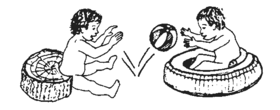 |
Old tires and drums can be used for crawling games and obstacle courses. |
BALANCE BOARDS |
||

|

|

A wider rocker base makes rocking smoother. |
| For the rocker, you can use 2 pieces of old tire. | ||
See more information on balance boards and balance beams.
ROLLS
 |
 |
 |
 A row of half buried old tires. The tires sink in when stepped on. A test of balance and great fun!
|
Old barrels, oil drums, paint cans, and logs make good playground equipment—for therapy and fun.
CRAWL-THROUGH DRUMS |
HANGING CRAWL-THROUGH DRUMS |
|
 |

CAUTION! Hold drums apart with sticks to prevent smashed hands and feet. |
 |
RING-TOSS |
|
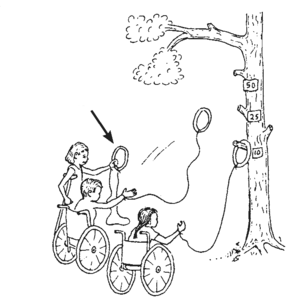 rings of tire rims or anything else |
 |
For children who have trouble going after dropped balls or rings, tying a string to the toy allows the children to pull it to them.


